Shrines and Deities of Worli Koliwada
Introduction
Humans have been perpetually battling hardships, disasters, and challenges brought about by natural forces and an ever-developing lifestyle. Continuously grappling with threats beyond their control, they attributed these threats and calamities to divine wrath. Humans began worshipping nature to appease its various forms, like the sun, moon, trees, plants, fire, water, earth, and animals. As human burial customs evolved, people began worshipping ancestral relics. The practice of appeasing ancestors gradually evolved, with people believing that pleasing the ancestral spirits would help them protect their settlements from disasters. Over time, ancestors transformed into deities, and stories about gods, goddesses, and divine incarnations emerged. Human existence, environment, and culture are inextricably linked, with each playing an important role in developing faith, communities, and values. Faiths and belief systems have been the guiding forces of humankind for ages. They contribute to shaping an individual's perspective on the world and often provide a support system and a sense of belonging.
A village, typically located in a rural area, faces a variety of challenges, including uncultivable lands, unpredictable, untimely, and insufficient rains, and the occurrence of diseases that affect both animals and humans, often resulting in fatalities. Villagers have traditionally resorted to rituals and rites to either control or appease the powers that they believed had sway over these phenomena. Villagers invoke Gramadevata, a local tutelary deity, for protection. Gramadevata is believed to protect the village and its inhabitants from natural calamities, diseases, and untoward events. For generations, the majority of rural Indian communities have worshipped Gramadevata as their primary deity. [1]
Situated at the tip of the plush locality of Worli in Mumbai is a gaothan, or an urban village, known as the Worli Koliwada, which is home to the indigenous fishing community of Mumbai, the Kolis, and the East Indians. The Worli Koliwada is rich with cultural, historical, and social significance. This essay aims to explore some of the places of worship based on the koliwada. Most temples have inscribed stone plaques, with the years of construction, renovation, or donations recorded in accordance with the Shaka/Saka Samvat calendar. The same plaque may also contain a Georgian equivalent. The Saka Samvat runs 78 years behind the Georgian calendar, except in the months from January to March, when it is 79 years behind.
Chede Dev Temple
The Chede Dev Temple greets visitors right at the entrance to Worli village. Chede Dev is a guardian deity believed to ward off evil powers from entering the village, thus protecting it from calamities. Donations from various firms and individuals have contributed to the temple's renovation and new look. A plaque on the temple's prayer hall wall displays a list of the aforementioned donors. Two plain, simple, and modified versions of stone deep malas (rows of oil lamps) flank the temple's entrance. The wooden door and windows of the temple have been ornately carved with floral motifs. The door consists of sculpted dwarapalas (guardian deities) and a metal relief of a lion head with a ring in its mouth that acts as the doorknocker. The temple's roof has latina (creeper) carvings, as well as two small lanterns hanging down from the ceiling. The temple has a small shikhara (spire) with a golden kalash (pitcher) on top. The design of the temple can be best described as ‘minimalist and modern.’ The sanctum sanctorum houses four stone idols smeared with shendur (vermillion). They are placed on a platform, and a brass lamp (samai) is positioned near the idols. A plaque at the platform's base mentions the name of the person who initiated the renovation process. The wall behind the idols features two lamps. The same wall has minimalistic flower depictions, enhancing its aesthetic value.
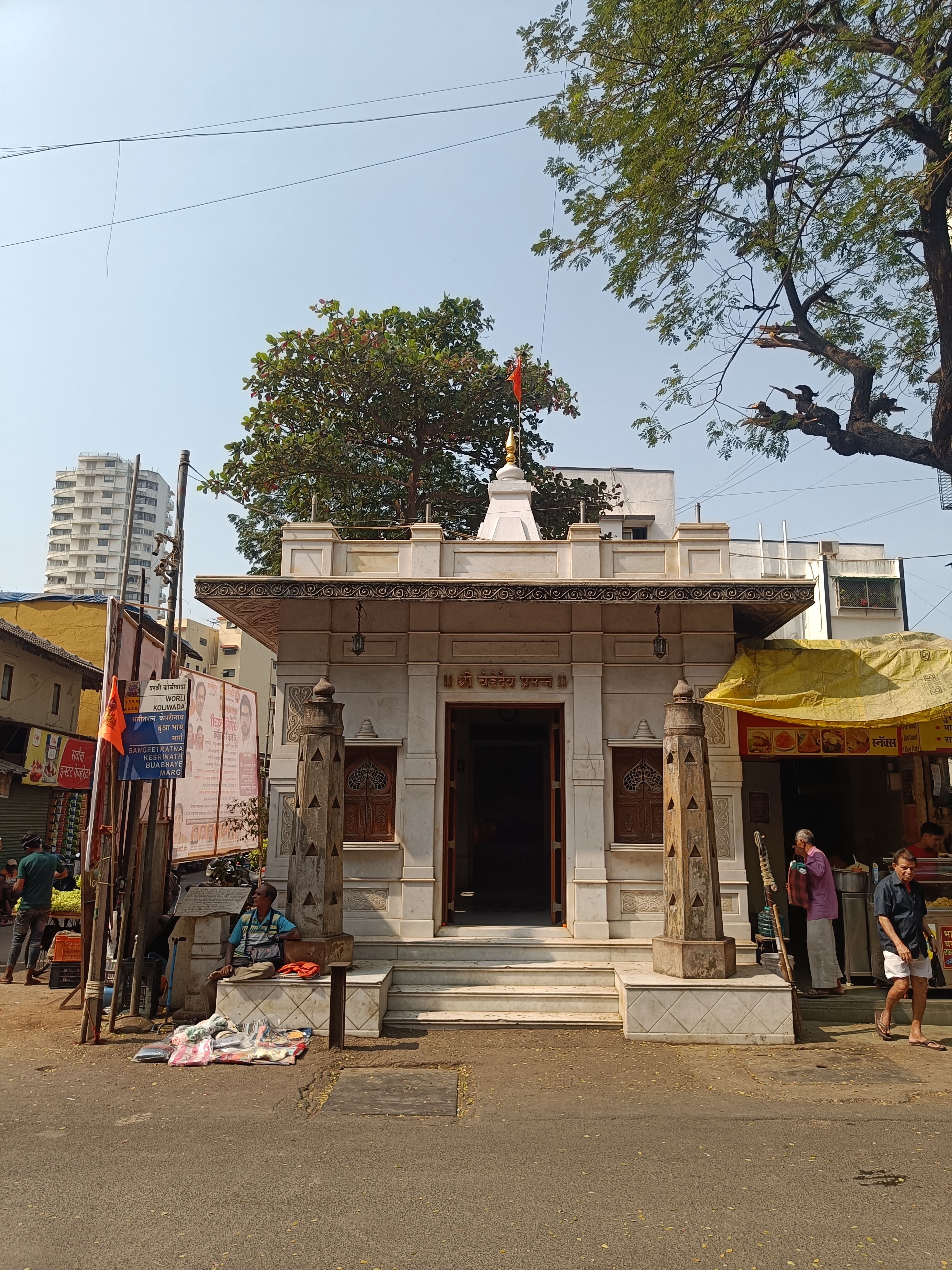
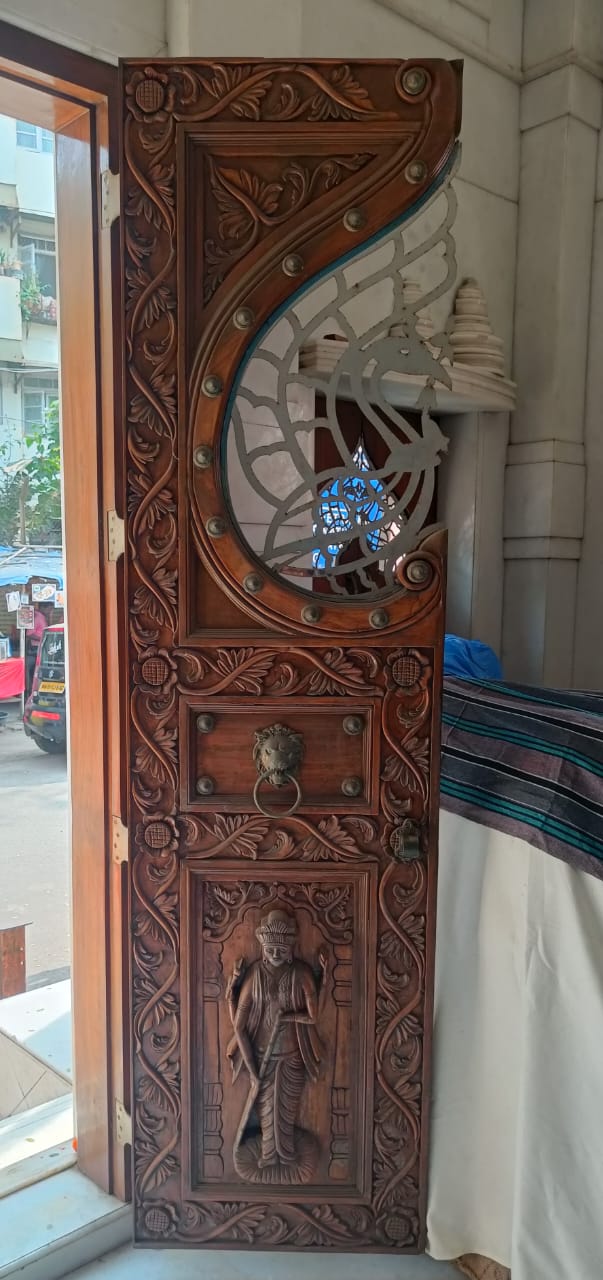
A common tradition across temples in India is to offer a shrifal (coconut) before starting something new or important. The Kolis from the Worli Koliwada offer a coconut at the Chede Dev Temple before travelling long distances and commencing auspicious functions. The temple follows the practice of kaul lavane, which involves invoking divine intervention. The temple priest typically performs a kaul ritual, placing flower buds, flowers, or leaves on the deity's upper right and left sides. Depending on which item falls first, the deity interprets it as a sign of favour or disfavour to the asked question. The exact date of construction or installation of the shrine for Chede Dev is uncertain. The temple was established by the village's ancestors, according to Mr. Vilas Worlikar (henceforth referred to as Mr. Vilas), a resident of Worli Koliwada and chairman of the Golfa Devi Mandir (Dharmadaya Trust). A few years ago, the temple underwent renovations.
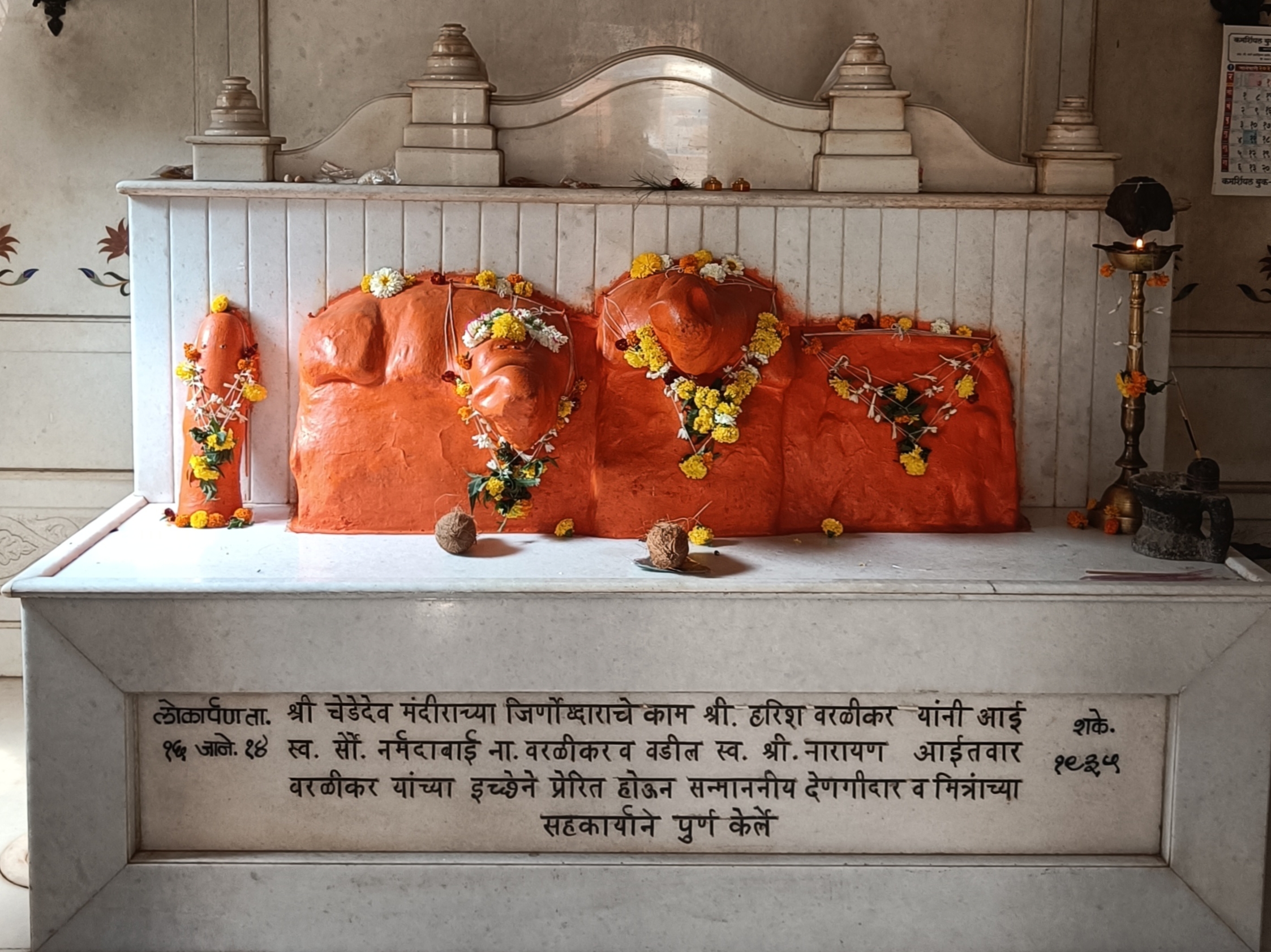
Papvimochneshwar Temple
On August 18, 1904, construction began on the Paapvimochneshwar Temple. The temple celebrates several religious and cultural festivals, including Kojagiri Pornima, Naag Panchami, Krishna Janmashtami, and Ram Navami. Of these, the most important are Maha Shivrati and the celebrations during the month of Shravan. Shravan is the fifth month according to the Hindu calendar, falling around the July–August months of the Georgian calendar. People arrange programs like kirtan (devotional singing) and haripath on Maha Shivratri. Haripath involves reciting abhangas, chanting, and praising Hari's name. A samudayik (communal) abhisheka also takes place. Abhisheka is the practice of pouring water or milk over a deity's image or idol. The palkhi (palanquin) procession on Maha Shivrati begins around five in the evening, covers the entire village's distance, and returns to the temple around three at night. They organise kirtan, haripath, and bhajan (devotional songs) in the month of Shravan.
A devotee donated a nagara (drum) to the temple on March 22, 1908. The drum was played during the morning and evening poojas in the temple and on important occasions. Mr. Vilas says that owing to the dwindling numbers and lack of craftspeople who repair and make traditional nagaras of leather, the practice of playing the drum has now been discontinued. A tulsi vrindavan (an altar housing the sacred tulsi plant) and two deep malas stand outside the temple. The steps leading to the temple's prayer hall bear a plaque stating the name of the donor who sponsored the steps' construction. The metal doors and railings of the temple, which bear Swastika and Aum symbols, are later additions to the structure. The temple has a sloping roof made of Mangalore tiles. A steep, multi-coloured shikara with a kalash (pot) crowns the temple. Several bells are placed hanging down from a horizontally placed wooden pillar in the prayer hall. The sanctum sanctorum, which comprises the Shivling, lies at a lower level compared to the prayer hall.
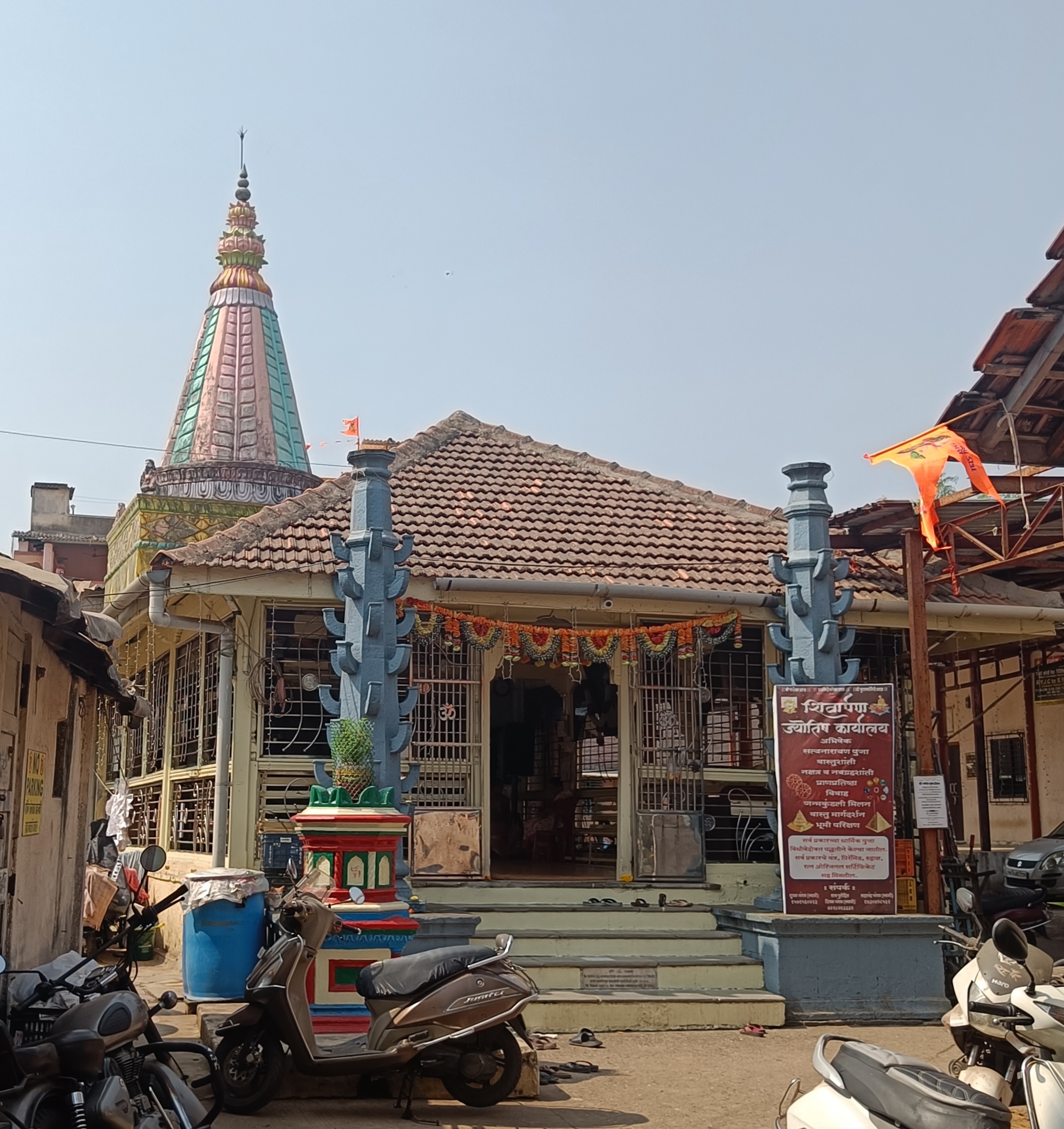
Maruti Temple
Narayan Kalokh Bhajan Mandali established the Maruti temple on April 18, 1954. Saint Dnyaneshwar's description from one of his Ovi texts guided the creation of the deity. [2] A single white marble stone serves as the meticulously carved idol of the deity. A stone plaque on one of the temple's prayer hall walls displays the list of donors who contributed to the Maruti Mandir's construction. The temple observes Hanuman Jayanti, celebrating the birth of Hanuman (also known as Maruti), every year.
Golfa Devi Temple
Golfa Devi is the Worli village's gramadevata (local tutelary deity). King Bhimdev, also known as Bimbdev and Bimbshah, is believed to have installed the temple on a tekdi (hill) in the village in the 12th century. The temple houses carved stone idols of Sakhba Devi, Golfa Devi, and Harba Devi, all covered in vermillion.
For the Koli community residing in the Worli Koliwada, Golfa Devi and her temple hold prime importance. Golfa Devi is famous as the ‘talking goddess’ of Worli. The kaul ritual enables the goddess to communicate with her devotees. The temple has fixed timings for seeking answers from the goddess through kaul. A kaul can be requested from the deity from sunrise until just before sunset, but in emergencies, it may be sought even at midnight, though this is reserved for exceptional situations. Only Golfa Devi and Harba Devi receive requests for the kaul.
The devotee can pose their question to the goddess either aloud or silently in their mind. The priest then places two chanderi supari (silver balls) to the right and left of the goddess. The right indicates a ‘yes’, while the left indicates a ‘no’. The Kolis interpret the answer as 'yes' or 'no' based on which side the ball falls on first. The Kolis seek permission from the Goddess before embarking on any endeavour, whether personal or communal. They won't proceed with any auspicious activity without receiving an affirmation from the goddess through the process of kaul lavane. Before venturing into the sea, the fishermen visit the temple to pray for a profitable catch.
The temple adorns the idols of the three sister goddesses with jewellery, garlands, and colourfully embroidered clothes. A crown of flowers rests on the heads of the idols. To the right of Golfa Devi is the sun, while to her left is the moon. The temple entrance features lions sculpted near the pillars, with a bell hanging between the two pillars. Floral motifs are used to decorate the dwar-shakhas (different layers of the door frame). Padma shakha (lotus petal motifs) decorate the innermost layer, while latina shakha (rows of creepers) adorn the outer layer. A kirtimukha (face of glory) rests on the central part of the lintel. The temple is still under construction, and the renovation process is ongoing. According to Mr. Vilas, the states of Tamil Nadu and Karnataka provided the stones for the structure's construction.
Everyday rituals performed in the temple include snana archana (bathing the Goddess) and abhisheka using panchamrut (a mixture made of milk, curd, ghee, honey, and sugar). Kapur (camphor) is used for puja. The smoke released from the camphor and the use of panchamrut gradually dull the shine and colour of the vermillion, detracting from the glossy and clean appearance of the idols. Therefore, people reapply the vermillion twice a year, once during the Navratra Utsav (Navratri festival) and later during the Shakambari pornima utsav, a festival in veneration of Goddess Shakambari.
The Shakambari Pournima falls in the Paush month of the Hindu calendar (January). The Golfa Devi Temple celebrates this major event. On this day, the Golfa Devi yatra (fair) takes place. Mr. Vilas informs us that the temple and its premises undergo a month-long cleaning as part of the preparations for the Golfa Devi yatra. The idols undergo a ten-day process of vermillion reapplication before the yatra. During these ten days, the temple is not open to visitors or devotees. Instead, they install a symbolic idol of Golfa Devi and venerate it for those ten days. A day before the Golfa Devi Yatra, a samudayik abhisheka and haripath are organized. Following the placement of the saree and ornaments on the goddesses, a puja takes place. Devotees open the temple to seek blessings from the goddess after the puja.
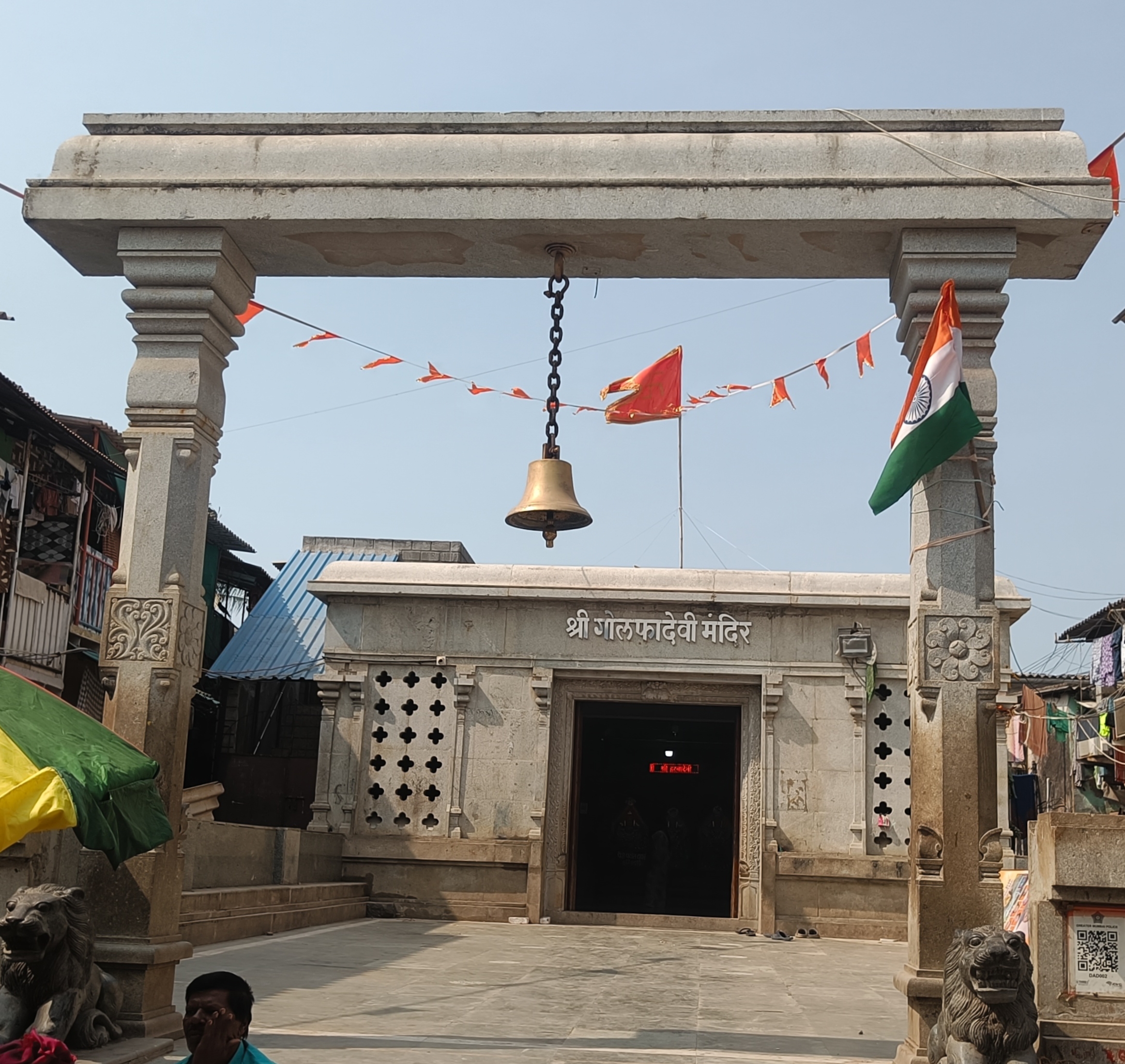
A navas is a promise a devotee makes to a god, offering something in return for the grant of a request. On Shakambari Pournima, people offer offerings to the Goddess in celebration of the completion of their navas. It is believed that sincere prayers result in the goddess fulfilling her requests. On Shakambari Pournima, people also make offerings at the Chede Dev and Vetal Temple. People prepare a naivedya (food offering) of shaak (leafy vegetables) for the goddess and place it to her right of the idol, believing she should accept it with her right hand.
The temple has been undergoing renovation for quite some time. During this process, workers placed the stones for the wall behind the goddess on October 6, 2005, taking care not to disturb the sculptures. On November 6, 2005, the vermillion from Sakbadevi’s feet came off, revealing her sculpted feet. The decision to remove the vermillion from all three idols and reveal their original stone-sculpted forms came after seeking permission from the goddess through kaul lavane. This attracted devotees to the temple, affecting the renovation process for a few days. Following this incident, the temple decided not to apply vermillion to the idols. However, the temple has resumed the practice of applying vermillion to the idols as of 2024.
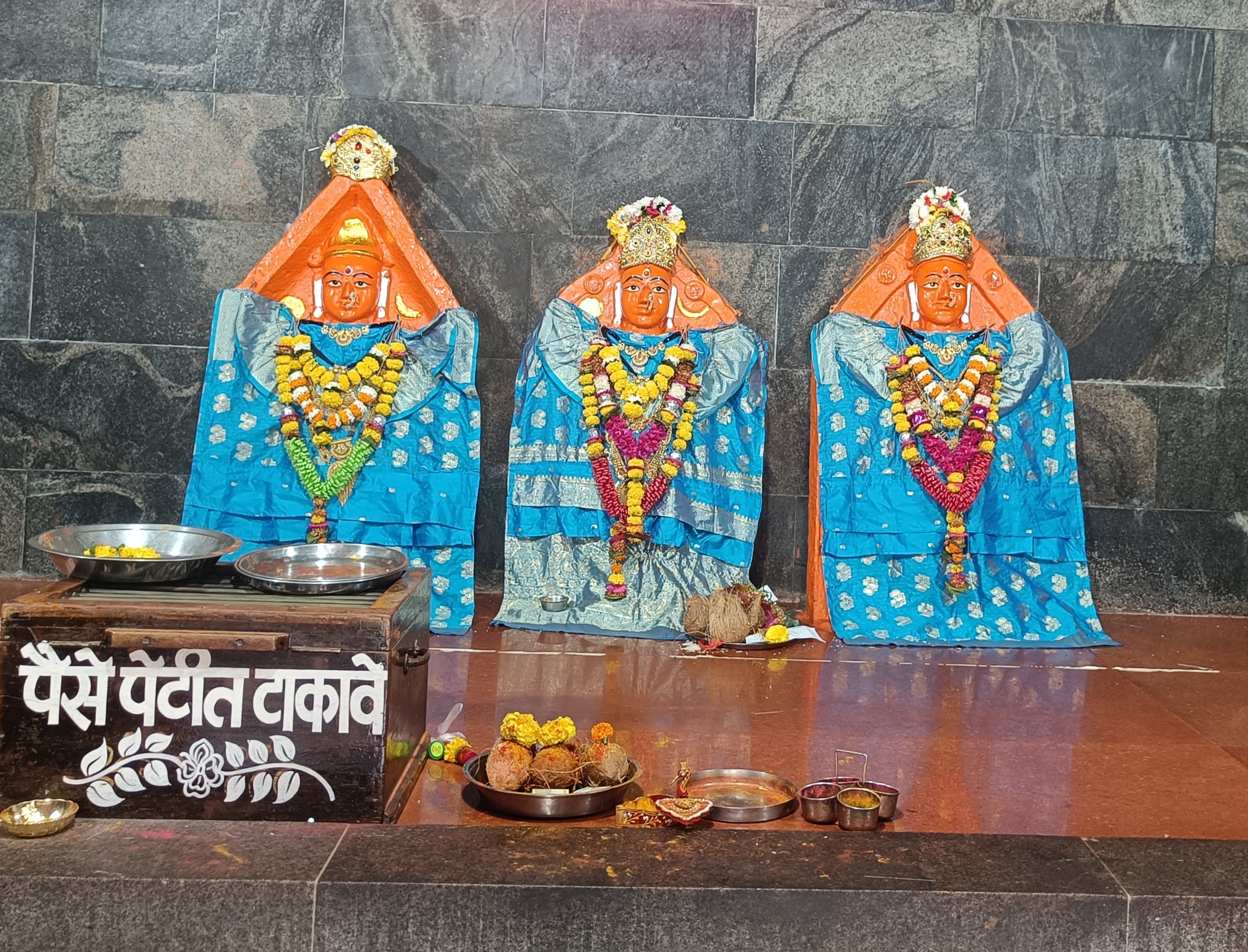
Vetal Temple
Located near the sea at the edge of the village is the Vetal Temple. This temple follows the practice of kaul lavne for the idols of Panyatla Vetal and Aagya Vetal, smearing them with vermillion. The temple also houses idols of the deities Sakhba Devi, Golfa Devi, and Harba Devi. A designated priest conducts the morning and evening puja at the temple.
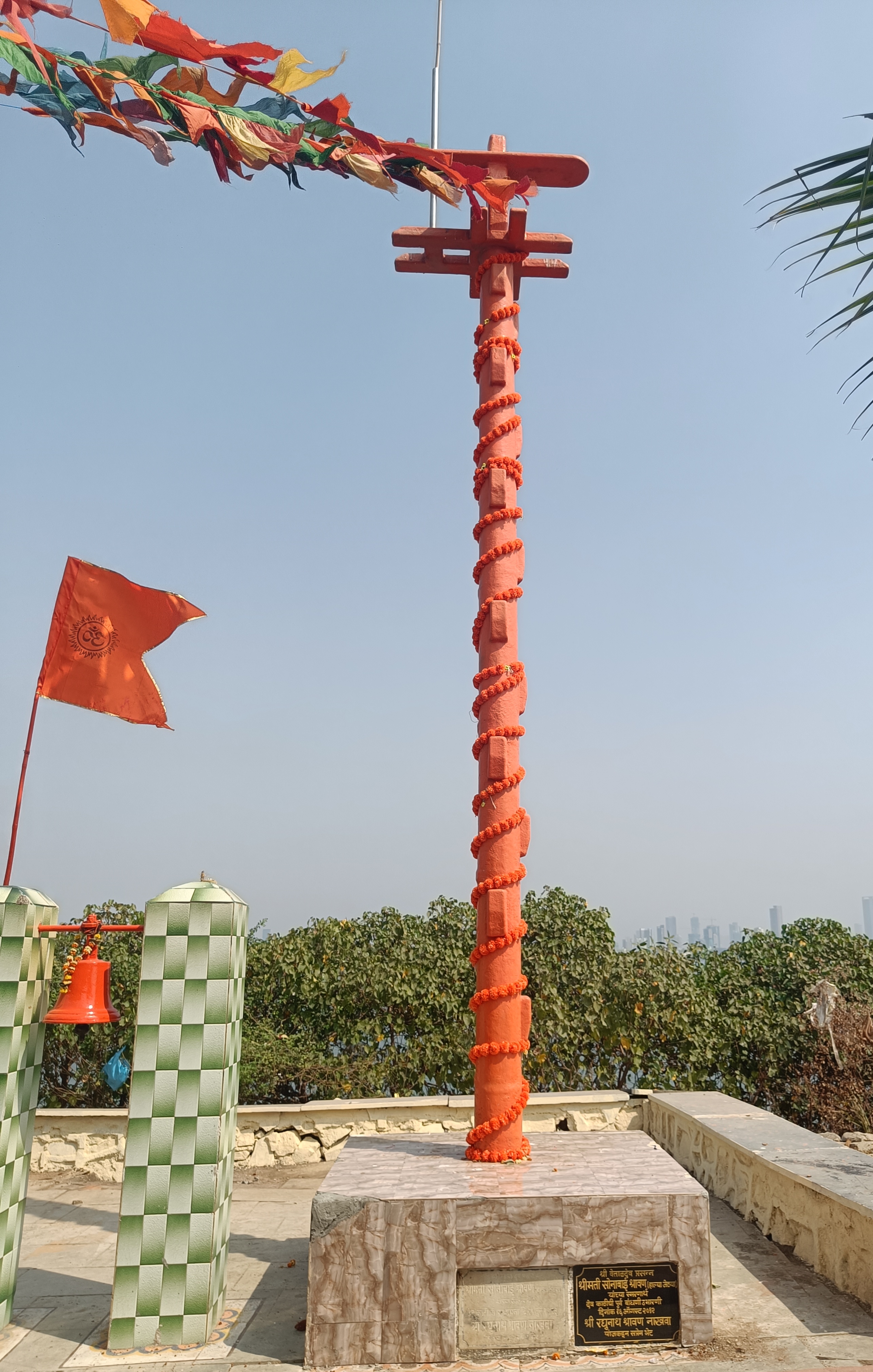

Before embarking on fishing trips, the Kolis offer prayers to Veta, seeking a bountiful catch and a safe return. Upon their return, they express gratitude to the deity for their safe journey. Outside the temple, there stands a dev kaathi, a wooden pillar painted in saffron, where a flag is hoisted on occasions like Narali Pournima and Paush Pournima. An inscription below the dev kaathi indicates its initial installation on July 26, 1993, and subsequent reinstallation on August 16, 2012. Beside the dev kaathi, a bell rests on a rod supported by two pillars, its exterior covered in vermillion. Although women cannot enter the temple's garbhagriha (sanctum sanctorum), they can still offer prayers from the outside. Tiles cover the outer walls of the temple.

Image 9
Pir Dargah
The Dargah is the village's sole Islamic shrine. The shrine worships two female saints, granting women access to the central shrine within the dargah.
Chapel
The chapel, located near the Vetal Temple at the village's edge, features an idol of Jesus Christ placed atop a small fishing boat. The chapel serves as a testament to the intersection of Koli culture with Christianity. The Christian Kolis residing in the Worli Koliwada hold a mass in the chapel to mark the beginning of the fishing season. The East Indian Koli Community resides in the Worli Koliwada, dotted with several grottos and crosses. Many of these grottos depict Mother Mary wrapped in a saree, adorned with flowers and garlands, and revered by the locals.
The Chede Dev Temple and the Vetal Temple, situated at the two extremities of the village, serve as guardians of the Koliwada, housing the shrines of the village’s guardian deities. These, along with the temple of Golpha Devi, form a triangular geographical system of protection for the village. Additionally, there is a Hanuman temple located at the Worli Fort near the gymnasium. Worshipping Hanuman is associated with achieving physical prowess and protection.
Change is an inevitable part of life. The advent of modernization and new technologies has had a significant impact on fishermen's lives and occupations. Fishing, being a labour-intensive job, struggles to keep up with the escalating prices of diesel, labour wages, and increasing demands for produce, particularly when the catch is considerably less than in the past. [3] Consequently, some Kolis have transitioned to other occupations. [4]
As mentioned before, traditionally, the Kolis sought the blessings of Golfa Devi before venturing out to the sea for fishing, with the deity being central to the Worli fishing community. However, as younger generations pursue a variety of occupations unrelated to fishing, the worship of Golfa devi has waned. [5] New faiths and religious affiliations have emerged, and the Kolis have adapted to accommodate them. The village has established temples venerating Lord Ram, Ganesha, Krishna, Datta, Sai Baba, and Santoshi Mata in recent decades.
By transcending religious barriers, the Worli Koliwada exemplifies diversity, coexistence, and syncretism. People from all communities visit the religious shrines within the Koliwada, irrespective of their religion, to seek blessings from the deity. This inclusive practice reflects the harmonious coexistence of different religious beliefs within the community.
Footnotes:
[1] Elgood, ‘Exploring the roots of Village Hinduism in South Asia,’ 328.
[2] Personal Interview of Mr Vilas Worlikar
[3] Ranade, ‘The Kolis of Mumbai at Crossroads: Religion, Business and Urbanisation in Cosmopolitan Bombay today.’
[4] Ibid
[5] Ibid
Bibliography:
Personal Interview of Vilas Anant Worlikar, in conversation with the author, February, 2024.
Chandra, Suresh. Encyclopaedia of Hindu Gods and Goddesses. New Delhi. Sarup & Sons, 1998.https://archive.org/details/encyclopaediaofhindugodsandgoddessessureshchandrasarupandsons406c
Elgood, Heather. ‘Exploring the roots of village Hinduism in South Asia.’ World Archaeology 36, no. 3 (September 2004): 326-342. https://www.researchgate.net/publication/249007442ExploringtherootsofvillageHinduisminSouth_Asia
Ranade, Sanjay Vasant. ‘The Kolis of Mumbai at crossroads: religion, business and urbanisation in cosmopolitan Bombay today.’ Paper presented at the ’Biennial Conference of the Asian Studies Association of Australia’, Monash University, Melbourne, Australia, July 1-3, 2008.
Worlikar, Vilas Anant. Worli Koliwadyachi Gramdevata Shree Golfa Devi, Shree Golfa Devi Prakashan, 2015